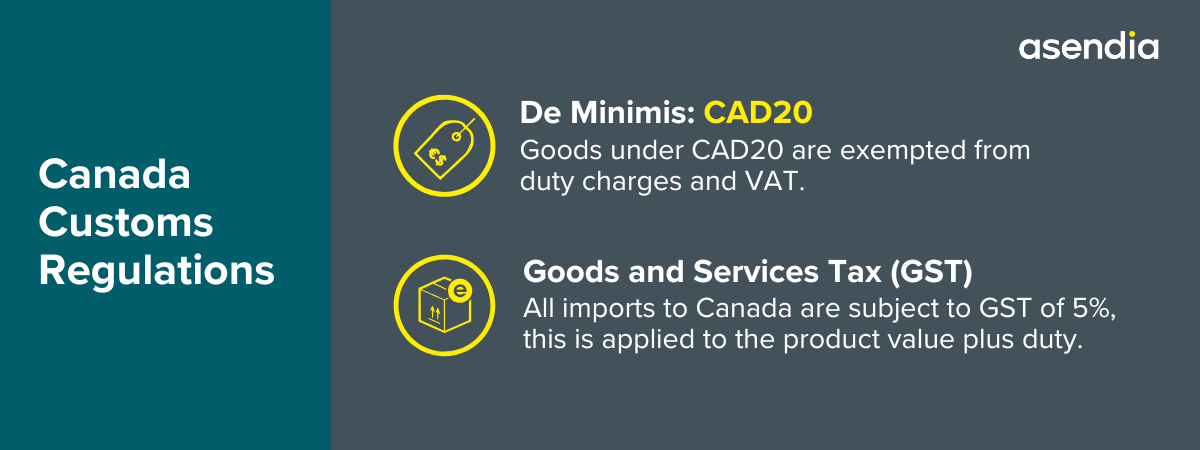Customs Regulations Overview in Canada

Canada has a De Minimis Value of CAD20 – this means you do not have to pay for tax and duties if your total shipment value is less than CAD20. However, if it exceeds the threshold value, you will have to pay for duties and taxes. Some other taxes may apply depending on the goods or their value, such as excise duty or taxes on luxury goods. If you are receiving gifts from a family member or friend abroad, you need not pay for the GST if the value is CAD60 or less.
Source: Canada Border Services Agency | ITA
Import Tax
Your imports to Canada are subject to GST or the federal part of the HST with exclusion for items specified as non-taxable importations. GST or HST are collected at the point of importation, together with duties and taxes.
- Goods and Services Tax (GST): Canada's GST is a 5% federal tax and is applied to the product value plus duty.
- There are several types of provincial tax in Canada:
- Provincial Sales Tax (PST) is a tax some Canadian provinces have added to the GST.
- Harmonized Sales Tax (HST) is used in some provinces, combining their Provincial Sales Tax (PST) and Goods and Services Tax (GST) into a single simplified rate.
- Quebec's Sales Tax (QST) is their unique provincial tax rate.
Depending on your destination province in Canada, the PST or HST rate varies. For more information on import requirements, duties, and taxes, you may visit the Canada Border Services Agency for further details.
Required Customs Documents
Before importing commercial goods into Canada, you will need to obtain a Business Number (BN) issued by the Canada Revenue Agency (CRA). It is usually free and can be obtained relatively quickly. You can visit the CRA’s website to register for a BN for import account.
There are a few customs documents that you need to prepare before importing goods into Canada:
1. Airway Bill or Bill of Lading
If your import is done via air freight, an airway bill is required. For shipments via sea freight, a Bill of Lading (BLAD) is needed. Both serve the same purpose: to provide detailed information about the shipment and enable tracking.
2. Canada Customs Invoice or Commercial Invoice
The commercial invoice is usually used to determine the true value of goods when assessing customs duties. Meanwhile, a Canada Customs Invoice (CCI) is a special invoice that contains more information than a standard commercial invoice.
If you are exporting to Canada and your commercial shipment value is CAD2,500 or above, you will need the CCI. The shipment items will also be subject to sales tax and other duties. There are some exceptions; for example, items covered by HTSUS Chapter 9810 do not need a Canada customs invoice.
The CCI typically includes the following:
- Items’ country of origin
- Transportation mode
- Currency of settlement
- Date of direct shipment to Canada
- Total weight
To view an example of the CCI or for more information, please visit Canada Border Services Agency’s website.
3. Canada Customs Coding Form (B3-3)
The B3-3 form is an accounting document used for paying duties and taxes. When properly filled, this form contains all the information needed to assist the CBSA in releasing shipment. This document usually includes the following information:
- Importer name and address
- Port of unloading
- Country of origin
- Direct shipment date
- Description
For more information on the Canada Customs Coding Form (B3-3), please visit Canada Border Services Agency’s website.
4. Certificate of Origin
The CBP Form 343 – North American Free Trade Agreement (NAFTA) Certificate of Origin is used to indicate where the goods were manufactured or originated. If the value of your shipment is more than CAD 3,000, you will need a NAFTA Certificate of Origin.
5. Electronics Export Information (EEI)
To ship goods across the border into Canada, you must complete the Electronics Export Information form. This form is used by the US Census Bureau to monitor trade statistics and guide trade regulations.




.jpg?width=2000&name=pexels-karolina-grabowska-5237646%20(1).jpg)

aa-1.jpg?width=2000&name=pexels-cottonbro-5076509%20(1)aa-1.jpg)
n.jpg?width=2000&name=pexels-ivan-samkov-7620627%20(1)n.jpg)







